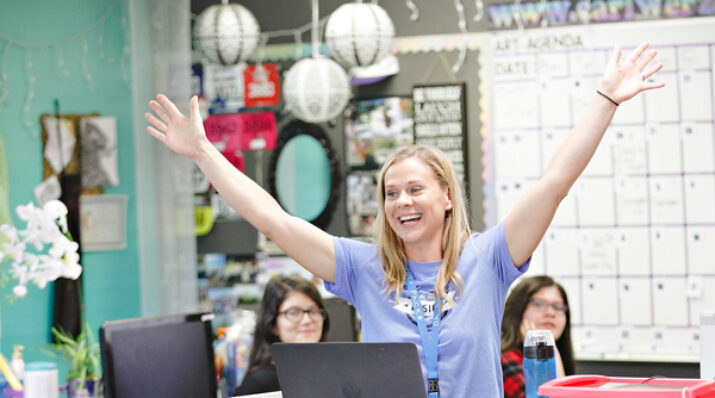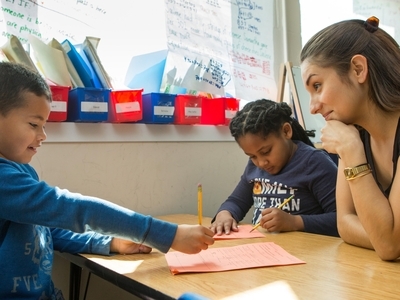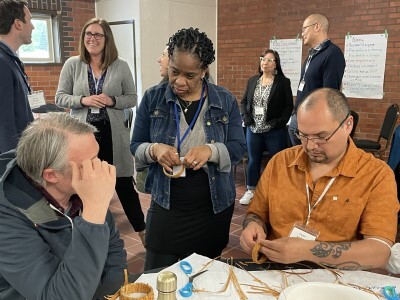Educators’ Light and Shadows: The Power of True Rest and Pause
Topics

Next generation learning is all about everyone in the system—from students through teachers to policymakers—taking charge of their own learning, development, and work. That doesn’t happen by forcing change through mandates and compliance. It happens by creating the environment and the equity of opportunity for everyone in the system to do their best possible work.
Teachers are applauded for all they do but their inherent humanity is ignored when they are not given time to rest and recover.
Like the school bell that marks the beginning and end of a year, our journey may have its ‘ding’ moments, but we all know teachers work their magic year-round. Teachers are “on” from before the first day of school until after the final bell rings. And after the final bell signals the end of the school year, that is when educators are cleaning, reflecting on the last year, and then immediately planning for execution for the next year.
As many of us in the social justice and social change sector know, project plans are the frameworks that help move the needle of our work forward. We need ample time for research and design, reflection and adjustment, execution, and then integration; rinse, repeat…
Unfortunately, educators don’t have this sacred portal of carved and built-in time for resourcing, planning, or designing. Researchers such as Hilda Borko and Richard Shavelson have summarized studies that reported 0.7 decisions per minute during interactive teaching. Further, in his book, Life in Classrooms, researcher Philip Jackson said that elementary teachers have 200 to 300 exchanges with students every hour (between 1200-1500 a day), most of which are unplanned and unpredictable calling for teacher decisions, if not judgments. Are we going the math here? The mental fatigue teachers face daily rivals that of the World Series when all bases are loaded and the last batter is walking up to the plate. But not just one time a year. All day, every day, all year long.
It’s safe to say that teachers are applauded for our production and execution.
We’re applauded for the ‘doing,’ the ‘outcomes,’ with little to no kudos for the toll it has on us.
This is only further underscored by the stereotype that teachers have summers off or that they work shorter days. We could riff on that, but that’s a digression for another post.
/////
During my second year in the classroom, my first as a second-grade teacher, I tore my meniscus. The meniscus is a C-shaped pad of cartilage in the knee that acts as a shock absorber. Ahead of the surgery, I planned nearly a month of substantial, informative, engaging lessons and experiences for my students. I made copies, bought math tools, and set books aside so that someone could comfortably support my students’ learning so I could support my body’s healing.
Less than a week post-op (no, truly, my surgery was on a Thursday and this happened the following Tuesday), I got a call from my principal to “Please, come back!” Even though all the plans were put in place weeks ahead of my scheduled absence, the substitute was pulled in another direction.
To reiterate, less than a week out of major knee surgery, I was requested to come back to the classroom: a classroom on the second floor of a building without an elevator.
Instead of focusing on my healing, I searched frantically for a wheelchair I could borrow and solidified logistics with my administration to be able to teach a room of second-graders while completely doped up on pain meds, without the ability to hold myself up. Oh! And, my principal informed me that I had been bold in asking for time off in the middle of the year instead of during a break… as if I could have planned that or would want to plan that.
That healing experience was less than ideal, however, what I want you to take away is that instead of holding my firm boundary, I was asked to push it down and cast myself aside, all to prioritize the service of others.
To this day, I hold anger and resentment around that. I told myself, if there was ever a next time, it’d be different.
/////
Fast forward to 2022. Two orthopedist visits later, an MRI confirmed that I had a tear in my shoulder labrum. To be able to compete and train in the ways I wanted to, I would need to undergo surgery. I knew this healing experience would be different. I wouldn’t push down my needs, or my wants; instead, I would use this as an opportunity to slow down, to be in alignment with the season of slowing down, and see how I may move, live, do, and be different.
Post-op, I was quite literally forced into rest. I wasn’t able to go for a run and escape my day. I wasn’t able to get on my yoga mat and tune out. I was very much told to sit, heal, relax.
As I moved through this major healing experience, I witnessed how my body didn’t just crave this deep rest but was indulging and luxuriating in it. The magnitude of quiet allowed me to embrace aspects of myself that I had built walls around: shame, judgment, criticism, and fear.
As I noticed these walls, I became curious.
What was this shame? Where did this shame reside and live in my body? Have I always felt this way? When and where did it begin? Who received feedback in ways that felt wrong? What parts of self have been neglected, turned off, told they don’t belong?
As I navigated these waters, I noticed they were dark shadows that were begging to be seen, to be acknowledged, to be witnessed, and perhaps...dare I say, to be honored.
I came to understand that holding space for darkness didn’t dim the light; oh no, in fact, it allowed me to see the light more clearly.
/////
I realized that my injury was a metaphor for the highest level of being comfortable in my body, embodiment. It forced me to take a magnifying glass to who I was, and how I was moving in this world—physically and emotionally. And I’ll be honest: this focus on production/doing/outcomes that I was living daily as an educator wasn’t me. It didn’t fit, and I needed to make big changes in my life.
As educators, we’re shown the ideal social media spotlight of what is a successful teacher and we’re holding up a bar of expectations that we can’t possibly meet 24/7. We become hyper aware of all the things we’re not doing or could be doing better. Most critically, this unrealistic image of a successful teacher sends the message that there’s something wrong with us, shaming our selves into burnout.
What’s wrong with being inherently human? It doesn’t fit the description of what a “good teacher” is.
I know other educators out there are told they’re not doing enough; those are the ones who risk burnout, lose their shine for education, and leave the profession. The more we tell ourselves this narrative of not enoughness and only applaud when things are shiny and bright, the darker the shadows become.
I know my story of healing from this shape-shifting, pushing down, or shame around our authentic human BEINGness isn’t just my story.
I know there are educators and teachers out there who desire a new way to live, be, teach, and lead.
The entirety of our experiences—the dark shadows, the bright light, and the entire spectrum in between—should be explored, tasted, and showcased.
To truly heal, to truly embody who we are as humans, as educators, and as teachers, we must allow ourselves to rest, to unplug, to disconnect. And not for an emphasis on being able to do more, to plug back in, or to connect. But merely because we’re human, too; we deserve carved containers of rest and pause.
Photo at top courtesy of Da Vinci Schools.




